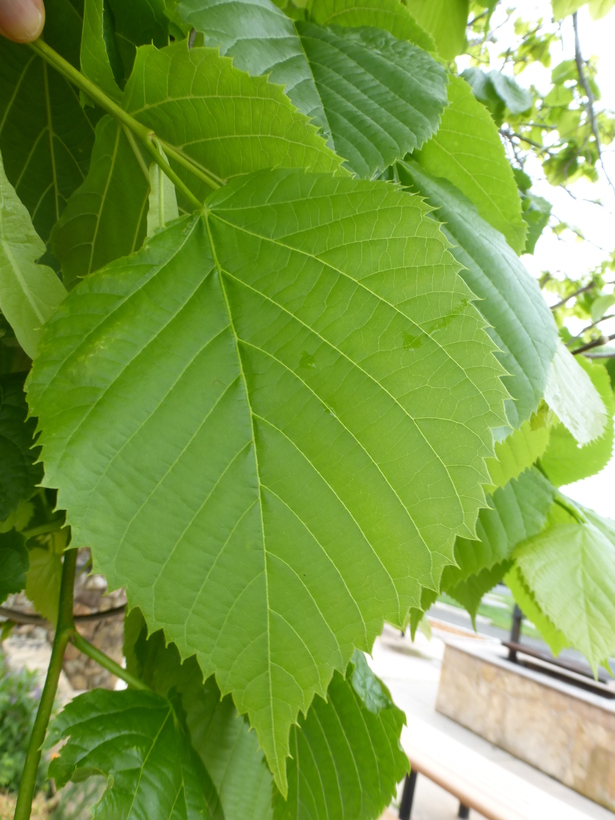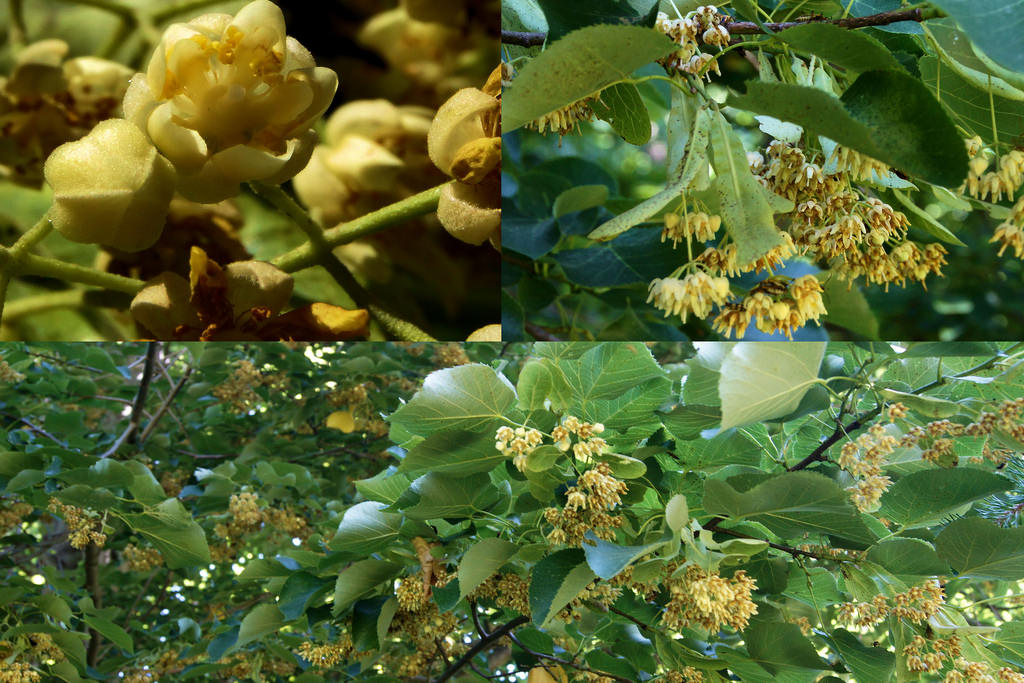American Basswood
Tilia americana L.
Description
American basswood (mallow family, Malvaceae) trees grow between 50 to 80 feet tall and have a spread of 35 to 50 feet¹. The leaves are four to eight inches long and are simple with an alternate arrangement, serrate margins, and pinnate venation¹. The leaf has a heart shape, but often with an asymmetrical base. In the spring and summer, the leaves are green, but in the fall they turn yellow¹. At first, the bark is smooth and gray-green in color². As the tree matures, it turns gray-brown and becomes rigid with long, shallow grooves and flat ridges². Small, pale, fragrant flowers are produced in early to mid-summer². The oval-shaped fruit grows below a leafy bract in a hanging cluster and is less than 0.5 inches long, tan in color, and covered with gray-brown hairs1,2.

Leaf of American basswood. @ Z. Akulova, 2020, CalPhotos8

Bracts and flowers of American basswood. @ B. Harms, 2011, Maryland Plant Atlas9
Distribution
American basswoods occur from southwestern New Brunswick, Canada and Maine, west to the south of Quebec, Canada, to southern and western Ontario, Canada, then to Michigan, Minnesota, and southeastern Manitoba, Canada³. Their range then extends south to eastern North Dakota, to northern and eastern Nebraska, to eastern Kansas, and northeastern Oklahoma. They are also found in Arkansas, Tennessee, western North Carolina, and New Jersey³. The American basswood is tolerant to clay, sandy, acidic, and alkaline soils¹. It also has a higher tolerance to shading than most large trees¹. In Maryland it is commonly found in the western portions of the state9 but it is also planted as a street tree elsewhere in the state10.

Native range of American basswood. USDA10
Wildlife Importance
White-tailed deer prefer to utilize American basswood as browse and birds and small mammals eat the fruit³. Its flowers attract honeybees which use the nectar to make honey3,4. Bees also use hollowed trees to store the honey4. The easily decayed wood creates cavities where nesting animals, such as ducks, birds, and other small mammals live³.
Economic Importance
Since the wood of the American basswood is soft, light, fine, and even-grained, it is widely used to make wood carvings¹. American basswoods are also important in the production of honey¹. The inner bark, called bast, was used by native Americans for fiber to make mats and rope ¹. The common name basswood is derived from from “bastwood” referring to the inner bark5.
Threats
High populations of white-tailed deer can reduce the height, or even kill American basswoods from overbrowsing³. Small mammals such as chipmunks, squirrels, mice, and rabbits enjoy feeding on the seeds of the smaller, younger trees which causes damage, or even death³. However, these small pests do not harm the fully mature trees³. The American basswood is extremely vulnerable to fungi and easily decays once infested³. Also, its thin, soft bark and hollow roots can be easily damaged by fire³.
Interesting Facts
- An American basswood typically lives, on average, to be about 100 years old, but some are known to have lived to be 140 to 200 years old6.
- The largest known American basswood is located in Kentucky7 and is 276 inches in circumference, 102 feet tall, and has a spread of 85.5 feet7.
- American basswood seedlings can grow as little as 25% sunlight3.
- The Native Americans and settlers also used the inner bark to make mats, fishing nets, and baskets6.
- Before synthetics basswood was the material of choice for prosthetics ¹.
References
- USDA NRCS Plant Guide: Basswood
- Virginia Tech Dendrology: American basswood
- USDA-Forest Service–Fire effects information system: Tilia americana
- University of Kentucky College of Agriculture, Food and Environment: American linden
- North Carolina Extension: Tilia americana var. heterophylkla
- Native American Uses of Basswood
- Champion Trees National Register: American basswood
- CalPhotos, UC BGerkely: Tilia americana
- Maryland Plant Atlas: Tilia americana
- USDA-Forest Service, Silvics, Vol. 2: Tilia americana
Contributed by J. Catrombon
